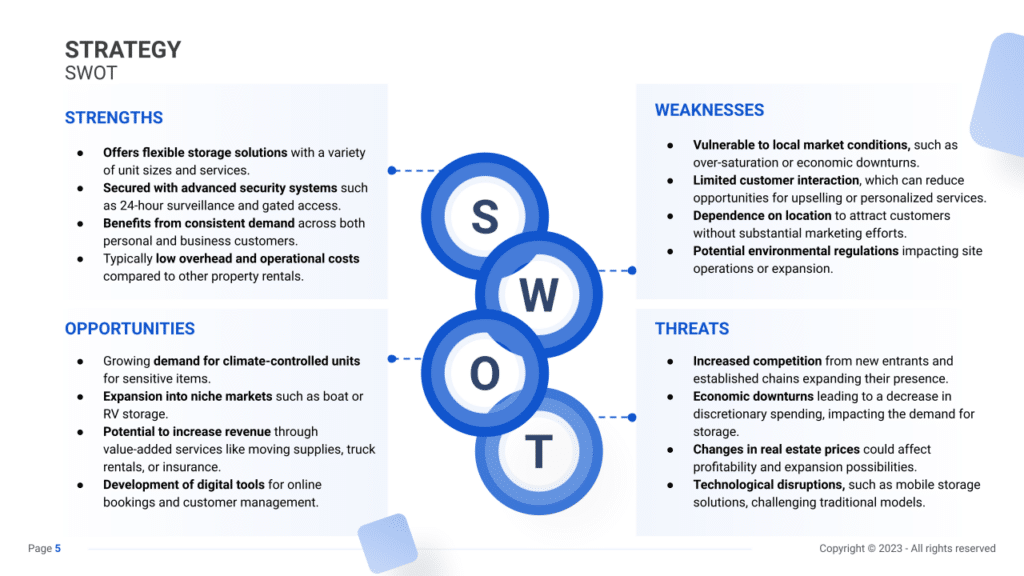SWOT Analysis for a Self-Storage Business (Example)

A SWOT analysis is crucial for developing a business plan for a self-storage business. This analysis, which stands for Strengths, Weaknesses, Opportunities, and Threats, helps understand internal and external factors that can impact your business. Strengths and weaknesses are internal to the business, while opportunities and threats are external.
In this article, we will explore various examples of strengths, weaknesses, opportunities, and threats, aiding self-storage business owners in crafting effective strategies.

Strengths
Highlight the strengths that distinguish your self-storage facility, creating a competitive advantage and fostering customer loyalty.
- Strategic Location: A prime location accessible to major highways or residential areas can be a significant strength, attracting clients seeking convenience and accessibility for their storage needs.
- Example: Emphasize the convenient location of your storage facility in marketing campaigns, highlighting easy access and proximity to key locations.
- Diverse Range of Unit Sizes and Features: Offering a variety of storage unit sizes and additional features like climate control or security systems cater to diverse customer requirements.
- Example: Showcase the range of unit sizes and features through online listings and informational brochures to attract a wider customer base.
- Excellent Security Measures: Implementing top-notch security systems, including CCTV surveillance, access controls, and on-site staff, helps build trust among clients concerned about the safety of their stored belongings.
- Example: Highlight the robust security measures in place on your website and during facility tours to reassure potential customers about the safety of their possessions.
- Strong Online Presence and Booking System: An efficient online platform for reservations, payments, and customer inquiries provides convenience and accessibility, setting your business apart.
- Example: Invest in a user-friendly website with an intuitive booking system, enabling customers to easily reserve storage units and manage their accounts online.
Weaknesses
Identify and address weaknesses within your self-storage facility to fortify operations and ensure sustainable success.
- Limited Brand Visibility: Lack of strong branding and visibility in the local market might result in lower customer acquisition and retention rates.
- Example: Develop a comprehensive branding strategy, including targeted marketing campaigns and community engagement initiatives to enhance brand recognition.
- High Maintenance Costs: Maintaining the facility, including upkeep of security systems, cleanliness, and property maintenance, can lead to substantial operational expenses.
- Example: Explore cost-effective maintenance solutions without compromising on service quality, such as energy-efficient systems or outsourcing certain maintenance tasks.
- Seasonal Demand Fluctuations: Fluctuations in demand during different seasons might result in periods of underutilization or overbooking of storage units.
- Example: Create incentives or promotions during low-demand periods to attract customers, or offer flexible leasing terms to accommodate varying storage needs.
- Limited Ancillary Services: Not offering additional services like packing supplies or transportation can limit potential revenue streams and convenience for customers.
- Example: Introduce ancillary services such as packing material sales or partnerships with moving companies to add value and convenience for clients.
Opportunities
Explore opportunities within your self-storage facility to capitalize on emerging prospects in the market.
- Urban Development and Population Growth: Increasing urbanization often leads to higher demand for storage solutions due to limited living spaces.
- Example: Capitalize on urban growth by targeting marketing efforts towards city dwellers facing space constraints for their belongings.
- Partnership with Real Estate Agencies: Collaborating with real estate agencies for referrals or providing storage solutions during property transitions presents an opportunity for increased clientele.
- Example: Establish partnerships with local real estate agencies to become their recommended storage solution for clients in need of temporary storage during moves.
- Digital Marketing and Online Presence: Investing in digital marketing strategies like SEO, social media campaigns, and online advertisements can widen the customer base.
- Example: Develop a robust digital marketing plan to enhance online visibility, engage potential clients, and drive traffic to your website.
- Specialty Storage Services: Identifying niche markets such as wine storage, vehicle storage, or business document archiving can diversify service offerings and attract specific customer segments.
- Example: Introduce specialized storage options and tailor marketing efforts towards these niche markets to attract customers with unique storage needs.
Threats
Anticipate and prepare for potential threats that could impact the stability and resilience of your self-storage business, ensuring proactive measures are in place to mitigate risks.
- Economic Downturns: Economic recessions or financial crises can impact disposable income, reducing demand for storage services.
- Example: Offer flexible pricing plans or discounts during economic downturns to attract budget-conscious customers.
- Competitor Expansion: Increased competition from new or established storage businesses in the vicinity might affect market share and pricing strategies.
- Example: Monitor competitors’ offerings and customer feedback to improve services and continuously differentiate from rivals.
- Regulatory Changes: Changes in local zoning laws, building codes, or tax regulations can impose additional costs or limitations on operations.
- Example: Stay updated on legislative changes and adapt business practices to remain compliant and avoid penalties.
- Technological Advancements: Rapid technological advancements might render existing security or operational systems obsolete, necessitating costly upgrades.
- Example: Allocate resources for continuous technological upgrades to stay ahead and ensure the security and efficiency of storage operations.





